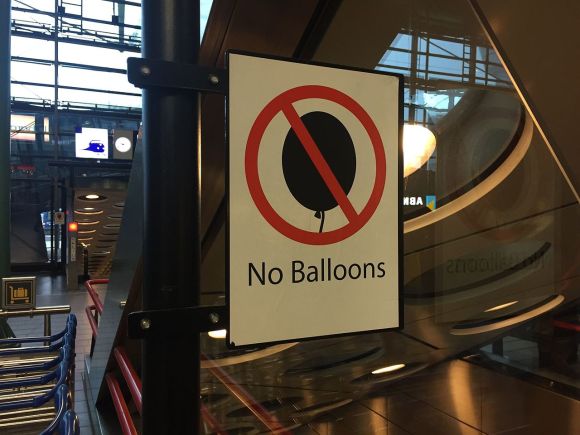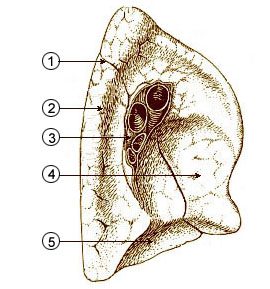
I’m going to go out on a limb and blame video games and gangsta rap for this one too.
Among the simplest joys in life is the humble balloon. What better way to spend a lazy afternoon that gently thwacking one around the living room with that strangely yet undeniably soothing “pom” sound.
But you may be saddened to learn that for some this highway to happiness is under serious construction with delays for miles, for these people do not possess the ability to blow up a balloon on their own. Even more tragic is how widespread this problem was recently discovered to be.
▼ This affliction causes some to lash out at society
It all started when a second-year high school student using the name Mifuyu wrote into NHK’s teenage talk show R No Hosoku asking for their help with a personal problem.
“I look stupid around my friends when I can’t blow up a balloon, so I want to be able to do it!”
Surprised by this problem, the show took to the streets of Tokyo to find out if not being able to blow up a balloon was actually a thing. They asked 100 teenage girls to blow up balloons and found that 31 of them could not do it.
Granted this isn’t the most scientific of surveys, but that’s probably more resources than anyone has ever put into the topic of schoolgirl balloon inflation in the past. So, we’re going to have to go with R No Hosoku as a leading authority on the topic for now and assume that 31 percent of high school girls in Japan cannot blow up a balloon.
This of course leads to the question of why?
● They don’t know to stretch the balloon first
By tugging on the balloon with your hands before attempting to blow it up, you can loosen the elasticity of the material thus requiring less lung power to blow it up. This may seem like common sense, but it’s often things like this that no one teaches people because everyone just assumes they already know.
Regardless, even after loosening up her balloons, Mifuyu was still unable to inflate hers. This means there must be other causes.
● It’s all in the lungs
Staying firmly in the land of common sense, an inability to blow up balloons would seem to stem from poor lung capacity. However, since we don’t usually see Japanese high school girls working the coal mines and smoking a pack of Marlboros a day, it would be odd if nearly a third of them had substandard lungs.
▼ Here is a diagram of a healthy human lung… or is that an unhealthy lung? They’re pretty gross either way.
Sure enough, when the program measured Mifuyu’s lungs against someone who could blow up a balloon, they turned out to be exactly the same at 2,200 milliliters. So this means there must be some other factor at play.
● Actually it’s all in the mouth
At a loss, the program consulted Miruyu’s dentist to make sure there were no abnormalities in her mouth that would cause her balloon related handicap. He confirmed that she had no problems with her jaw, meaning that her problem must simply be the muscles in her mouth.
It turned out that when Mifuyu blew into the balloon the air followed the path of least resistance, namely her flimsy cheek muscles causing them to comically puff out. This also greatly diminishes the force of the air, leaving insignificant pressure to expand the balloon. However, when a friend placed their hands firmly over Mifuyu’s cheeks, she could successfully inflate a balloon.
And so, apparently the mouths of teenage girls in Japan are so weak they are defeated by a child’s toy. It’s a little surprising if you’ve ever heard a group of teen girls talking away about the latest David Cassidy album jacket, or whatever it is they go on about. They certainly do seem to have jowls strong enough to chew through sheet metal, but it just goes to show that you can’t judge a book by it’s audio version.
▼ “I don’t know why other people seem to enjoy these so much. It just tastes like air…”
However, this bodes poorly for the future of Japan if the bleak post-apocalyptic world of air bladder warfare predicted in the grim NES game Balloon Fight ever occurs.
Source: NHK/R No Hosoku
Top image: Wikipedia/D Sharon Pruitt
Inset images: Wikipedia/Wittylama, Wikipedia, Pakutaso




 More Japanese schoolgirls think themselves overweight than those in China, Korea or the U.S.
More Japanese schoolgirls think themselves overweight than those in China, Korea or the U.S. Japanese baseball mascot kicks and punches another mascot lying defenceless on the ground【Video】
Japanese baseball mascot kicks and punches another mascot lying defenceless on the ground【Video】 Absolutely wow: Dawn of the new year seen from 30 km up【video】
Absolutely wow: Dawn of the new year seen from 30 km up【video】 Japanese magician’s cutting-edge performance stuns judges on Britain’s Got Talent 【Video】
Japanese magician’s cutting-edge performance stuns judges on Britain’s Got Talent 【Video】 Chinese police force called in to investigate New Year decoration
Chinese police force called in to investigate New Year decoration Beautiful new Final Fantasy T-shirt collection on the way from Uniqlo【Photos】
Beautiful new Final Fantasy T-shirt collection on the way from Uniqlo【Photos】 Randomly running into a great sushi lunch like this is one of the best things about eating in Tokyo
Randomly running into a great sushi lunch like this is one of the best things about eating in Tokyo Disney princesses get official manga makeovers for Manga Princess Cafe opening in Tokyo
Disney princesses get official manga makeovers for Manga Princess Cafe opening in Tokyo Is the new Shinkansen Train Desk ticket worth it?
Is the new Shinkansen Train Desk ticket worth it? We tried Japan’s Strawberry Daifuku? liqueur, one of three dessert-themed liqueurs
We tried Japan’s Strawberry Daifuku? liqueur, one of three dessert-themed liqueurs Hey, Japanese taxi driver! Take us to your favorite restaurant in Tsuruga City!
Hey, Japanese taxi driver! Take us to your favorite restaurant in Tsuruga City! Starbucks releases a special sparkly tumbler in Japan to support diversity
Starbucks releases a special sparkly tumbler in Japan to support diversity What happens to Cup Noodle Mystery Meat when you cook it in a rice cooker?
What happens to Cup Noodle Mystery Meat when you cook it in a rice cooker? Japanese black curry “experiment” takes place at an unlikely restaurant branch in Tokyo
Japanese black curry “experiment” takes place at an unlikely restaurant branch in Tokyo New Studio Ghibli bedding sets are cool in all senses of the word
New Studio Ghibli bedding sets are cool in all senses of the word We try out “Chan Ramen”, an underground type of ramen popular in the ramen community
We try out “Chan Ramen”, an underground type of ramen popular in the ramen community Our Japanese reporter visits Costco in the U.S., finds super American and very Japanese things
Our Japanese reporter visits Costco in the U.S., finds super American and very Japanese things Foreign English teachers in Japan pick their favorite Japanese-language phrases【Survey】
Foreign English teachers in Japan pick their favorite Japanese-language phrases【Survey】 New Pokémon cakes let you eat your way through Pikachu and all the Eevee evolutions
New Pokémon cakes let you eat your way through Pikachu and all the Eevee evolutions There’s a park inside Japan where you can also see Japan inside the park
There’s a park inside Japan where you can also see Japan inside the park Japanese convenience store packs a whole bento into an onigiri rice ball
Japanese convenience store packs a whole bento into an onigiri rice ball Hanton rice — a delicious regional food even most Japanese people don’t know about, but more should
Hanton rice — a delicious regional food even most Japanese people don’t know about, but more should Final Fantasy, Kingdom Hearts, and Dragon Quest pet product line announced by Square Enix
Final Fantasy, Kingdom Hearts, and Dragon Quest pet product line announced by Square Enix Studio Ghibli releases Kiki’s Delivery Service chocolate cake pouches in Japan
Studio Ghibli releases Kiki’s Delivery Service chocolate cake pouches in Japan Japan’s bone-breaking and record-breaking roller coaster is permanently shutting down
Japan’s bone-breaking and record-breaking roller coaster is permanently shutting down New definition of “Japanese whiskey” goes into effect to prevent fakes from fooling overseas buyers
New definition of “Japanese whiskey” goes into effect to prevent fakes from fooling overseas buyers Foreign passenger shoves conductor on one of the last full runs for Japan’s Thunderbird train
Foreign passenger shoves conductor on one of the last full runs for Japan’s Thunderbird train Kyoto bans tourists from geisha alleys in Gion, with fines for those who don’t follow rules
Kyoto bans tourists from geisha alleys in Gion, with fines for those who don’t follow rules Studio Ghibli unveils Mother’s Day gift set that captures the love in My Neighbour Totoro
Studio Ghibli unveils Mother’s Day gift set that captures the love in My Neighbour Totoro Domino’s Japan now sells…pizza ears?
Domino’s Japan now sells…pizza ears? Toyota built a life-sized Miraidon Pokémon and are letting people test drive it this weekend
Toyota built a life-sized Miraidon Pokémon and are letting people test drive it this weekend New Japanese KitKat flavour stars Sanrio characters, including Hello Kitty
New Japanese KitKat flavour stars Sanrio characters, including Hello Kitty Sales of Japan’s most convenient train ticket/shopping payment cards suspended indefinitely
Sales of Japan’s most convenient train ticket/shopping payment cards suspended indefinitely Sold-out Studio Ghibli desktop humidifiers are back so Totoro can help you through the dry season
Sold-out Studio Ghibli desktop humidifiers are back so Totoro can help you through the dry season Japanese government to make first change to romanization spelling rules since the 1950s
Japanese government to make first change to romanization spelling rules since the 1950s Ghibli founders Toshio Suzuki and Hayao Miyazaki contribute to Japanese whisky Totoro label design
Ghibli founders Toshio Suzuki and Hayao Miyazaki contribute to Japanese whisky Totoro label design Doraemon found buried at sea as scene from 1993 anime becomes real life【Photos】
Doraemon found buried at sea as scene from 1993 anime becomes real life【Photos】 Tokyo’s most famous Starbucks is closed
Tokyo’s most famous Starbucks is closed One Piece characters’ nationalities revealed, but fans have mixed opinions
One Piece characters’ nationalities revealed, but fans have mixed opinions We asked a Uniqlo employee what four things we should buy and their suggestions didn’t disappoint
We asked a Uniqlo employee what four things we should buy and their suggestions didn’t disappoint Princesses, fruits, and blacksmiths: Study reveals the 30 most unusual family names in Japan
Princesses, fruits, and blacksmiths: Study reveals the 30 most unusual family names in Japan Studio Ghibli’s new desktop Howl’s Moving Castle will take your stationery on an adventure
Studio Ghibli’s new desktop Howl’s Moving Castle will take your stationery on an adventure “Diet with Your Girlfriend” app lets you do the exact opposite of that
“Diet with Your Girlfriend” app lets you do the exact opposite of that Japanese balloon jellies, or “Tengu’s Treasure”, are a very unique souvenir
Japanese balloon jellies, or “Tengu’s Treasure”, are a very unique souvenir Huge anime character balloon terrifies all it encounters, gives viewers a literal tongue lashing
Huge anime character balloon terrifies all it encounters, gives viewers a literal tongue lashing Team Rocket outlines recruitment project in Saga Prefecture
Team Rocket outlines recruitment project in Saga Prefecture Giant flying Totoro balloon appears at Tokyo’s Ghibli Museum【Video】
Giant flying Totoro balloon appears at Tokyo’s Ghibli Museum【Video】 Explore the exquisite beauty of “Pops’ Fart-loon” fireworks
Explore the exquisite beauty of “Pops’ Fart-loon” fireworks Hokkaido company to start balloon ride service to the stratosphere
Hokkaido company to start balloon ride service to the stratosphere Scientists in California send classic SNES EarthBound cartridge on odyssey into space【Video】
Scientists in California send classic SNES EarthBound cartridge on odyssey into space【Video】 Oregon as a Studio Ghibli film – Gorgeous tourism video shows the state as a Miyazaki wonderland
Oregon as a Studio Ghibli film – Gorgeous tourism video shows the state as a Miyazaki wonderland Japanese astronaut sends a picture to the world, world has Photoshop battle【Photos】
Japanese astronaut sends a picture to the world, world has Photoshop battle【Photos】 Hackers to Gundam: 5 rumors about failed North Korean missile launch surface on Japanese Internet
Hackers to Gundam: 5 rumors about failed North Korean missile launch surface on Japanese Internet Some of Japan’s COVID-19 contact tracing apps haven’t been working since last September
Some of Japan’s COVID-19 contact tracing apps haven’t been working since last September We ride one of Japan’s most accidentally terrifying trains
We ride one of Japan’s most accidentally terrifying trains Middle-aged man arrested for stealing whistles from little girls
Middle-aged man arrested for stealing whistles from little girls Moon prism power-up your balloon art with Princess Serenity and Queen Elsa
Moon prism power-up your balloon art with Princess Serenity and Queen Elsa
Leave a Reply